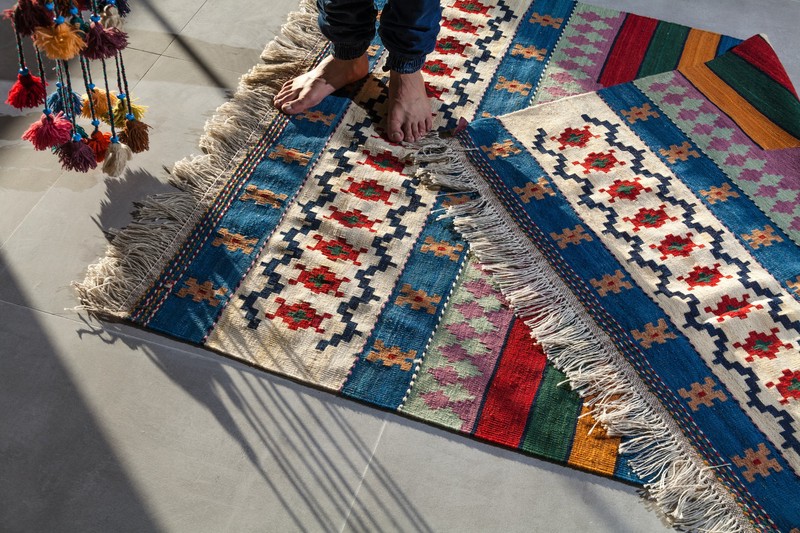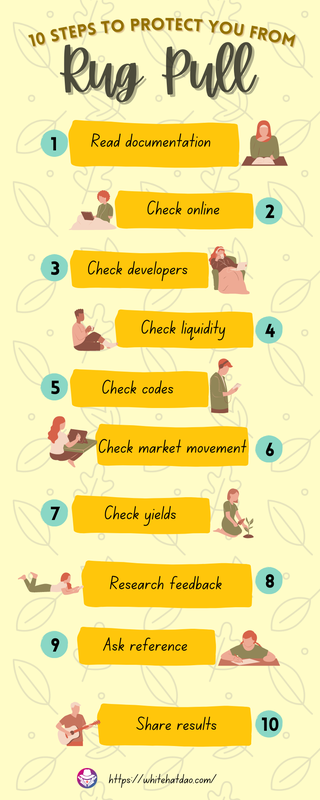
Rug pulls are very common in the crypto space. It is a type of exit scam in which creators of such crypto products inflated their price and valuation to attract more buyers and suddenly sold to cash out so that the market will tank into the near-zero valuation. So how to spot rug pulls and prevent them?
TL;DR
Rull pulls are preventable if you follow these 10 steps.
Categories
There are 3 categories of rug pulls so far. Liquidity stealing, limiting sell orders, and dumping.
Liquidity stealing happens when liquidity pools in Defi products suddenly withdraw all money and bring valuation to zero.
Limiting sell orders happens when a crypto product has embedded codes to prevent the selling of tokens or to prevent investors to cash out.
Dumping happens when creators of crypto products or developers suddenly sell all their digital assets to exchange cash and leave investors alone.
Each of the categories above happened unexpectedly and quickly without any warning.
Rug pulls Can Be Illegal
Some countries or regions make rug pulls illegal. According to Hong Kong Regulators and Crypto Exchanges, only licensed crypto-exchanges will be allowed to operate and any suspicious or fraudulent activity may be brought into the police investigation. Both claims can bring criminal or civil charges. However, those may apply if there is a requirement of KYC or Know-Your-Customers.
How to Spot A Rug Pull
Here are steps for you to reference and follow:
Step 1: read documentation
Doing your own due diligence can help you to understand the crypto products while helping you to avoid potential rug pull. Start with their whitepaper and roadmap if they have any. Looking particularly into reference citations to see if those references are credible.
Step 2: Check online
Research online such as coinmarketcap.com or coingecko.com to get yourself familiar with their community or any other data. The key is to gather as much information as possible.
Step 3: check developers
Pay particular attention to the identification of developers and their holdings of tokens, anonymous or large concentration on a few developers' holdings are all red flags signs of potential rug pulls.
Step 4: check liquidity
Pay attention to low liquidity or no liquidity locked. Those signs are rug pull potential red flags. Low liquidity means you may not be able to cash out. Liquidity locked level should be between 0% to 100%. If there are third-party lockers that may give more security to the crypto products rather than self guarantees lockers from developers themselves.
Step 5: check codes
No audit codes are dangerous. There is a rug pull potential if there are selling restrictions embedded in as hidden codes.
Step 6: check market movement
Overnight success or price skyrocket is a sign of rug pulls. Don’t let FOMO control you, let logic help you to find out what this product is really and how it should work from their statements.
Step 7: check yields
If yields are too good to be true, then such a product likely has a rug pull potential. Compare it with similar products to get a general idea about annual percentage yield (APY).
Step 8: research feedback
Try to join their community or check their blockchain to see if there are comments and feedback on the products. Many users will leave their feedback in comment sections to help others. Community channels are also useful. Reach out to their team and asking questions before purchasing anything is a key to helping you avoid rug pull.
Step 9: ask reference
Try to post your questions online and ask others to help you to understand the products. The more responses you get, the less likely you will encounter rug pull.
Step 10: share results
Last but not least, share your thoughts about the products online and help others to understand them. It helps everyone to aware of one experience and learns from it.

In Conclusion
Rug pulls are avoidable if you do your due diligence. It is a learning process rather than clicking without thinking. Try to take it slow and learn, rug pulls can be prevented.
Follow me here
Photo by Sina Saadatmand on Unsplash
Disclosure: The article was written by a delusional author who is possibly a nut job without any questions whatsoever about expertise in the subject matters. You should not believe any words this author wrote or you may experience similar symptoms or even possibly become a nut job.
Resources
https://coinculture.com/au/markets/what-are-the-biggest-rug-pulls-in-crypto-history/
https://www.cybertalk.org/2021/09/02/defi-cryptocurrency-rug-pulls/
Comments